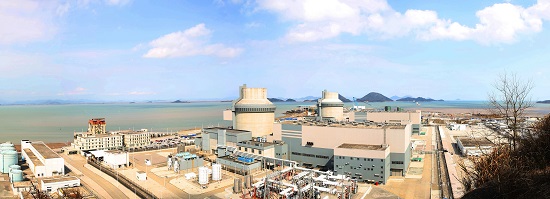
World's first AP1000 third-generation nuclear unit begins fueling on April 25 in east China's Zhejiang Province, a much-awaited landmark in China's actualization of the arguably advanced technology, and a step closer to its mass-manufacture and export of third-generation nuclear facilities.
Permitted by National Nuclear Safety Administration of China, uranium fuel rods were loaded into the honeycomb core of the 1250-megawatt number one unit reactor of Sanmen nuclear power station in costal Zhejiang Province, marking the plant has started a trail run.
State Nuclear Power Technology Corporation (SNPTC), a company of State Power Investment Corporation (SPIC) is the developer and contractor of the Sanmen nuclear power project. The number one unit will be put into operation within this year.
SPIC introduced the third-generation pressurized water reactor design AP1000 (AP means Advanced Passive) from the U.S. company Westinghouse Electric Corporation in November 2006. Since then China has built two AP1000 units in Sanmen, and another two in Haiyang, east China's Shandong Province.
The Sanmen project is of significance to China's nuclear energy development. The AP1000 is the world's safest reactor technology for commercial purpose. It is designed to passively cool itself during an accidental shutdown, theoretically avoiding accidents like those at Ukraine's Chernobyl power plant and Japan’s Fukushima Daiichi.
If all goes smoothly at the Sanmen facility, the Chinese could unleash a wave of approvals for new reactors. Bloomberg has reported that South Africa, India, Mexico and the Czech Republic are among other countries also considering the design, and are more likely to adopt it once China has taken the first, crucial step.
As the cooperation between SPIC and China National Nuclear Corporation, the constructions of Sanmen nuclear plant started in April 2009. It is designed to build six 1250MW reactors, altogether 7.5GW installed capacity.
What is notable for China, over 55 % of the facilities are produced by domestic firms. More than 40 Chinese manufactures, including Dongfang Electric, China National Erzhong Group have broken technical bottlenecks to localize the production of key equipment like pressured vessel, vapor generator and more. These progresses pave the way for further deployment of such type in China and around the world.
On the basis of AP1000 technology, China is researching and developing its upgrade version, CAP1400 (C means China), which will become more stable, safer and powerful. More importantly, China owns the intellectual property right of CAP 1400.
Currently, the engineering work is steadily in scheduled process. SPIC has developed its indigenous simulated digital control system for CAP1400 nuclear model, NuSIM, which simulates the normal operations and possible emergencies of a nuclear power station, and can be used to train future nuclear station operators.
According to SPIC, the company is building two CAP1400 reactors in a demonstration project located in Shidao Bay, Rongcheng city of east China's Shandong Province. As much as 85% percent of equipment in Rongcheng nuclear project will be made-in-China.
In May 2016, CAP1400 has successfully passed the International Atomic Energy Agency's (IAEA) Generic Reactor Safety Review, clearing the hindrance to export it as well as deploy the advanced reactor design. SPIC have teamed up with 160 companies from both home and abroad to build a global supply chain of AP1000 and CAP1400 equipment, making it a powerful international marketer of such models.